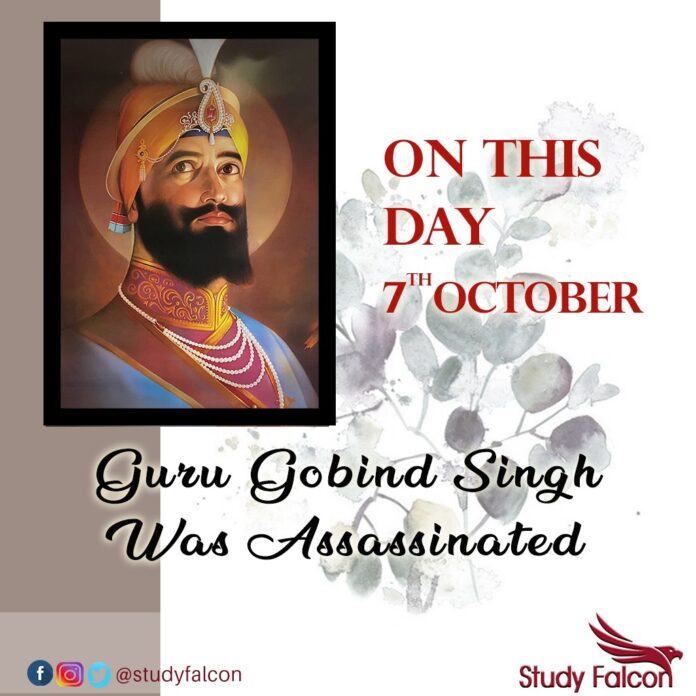Guru Gobind Singh was the Tenth Guru of the Sikhs. He was born in Patna, India, son of the ninth Sikh Guru Tegh Bahadur. Guru Gobind Singh became the spiritual and temporal leader of the Sikhs on November 11, 1675, at the young age of nine years. He was renowned as a warrior, a poet, and a prophet. His establishment of the Khalsa is considered to be one of the most important events in the history of Sikhism.
He is fondly remembered by Sikhs as a defender of the faith and a champion of equality and justice. He is also known as the last human Sikh Guru who wrote the Dasam Granth, and declared that hence forth the Guru Granth Sahib would become the next permanent Sikh Guru.
Details on Guru Gobind SIngh’s life can be derived from the Bichitra Natak, which is considered to be Guru Gobind Singh’s autobiography. The Bichitra Natak is a part of the Dasam Granth, a literary collection attributed to Guru Gobind Singh.
Guru Gobind Singh was born as Gobind Rai in Patna, Bihar, to the ninth Sikh Guru Teg Bahadur and his wife Mata Gujri. Gobind Rai spent the first five years of his life in Patna. His father, Guru Tegh Bahadur, had founded the city of Anandpur in the year 1665, on the land purchased from the ruler of Bilaspur; land that would later be in dispute. After his tour of eastern parts of India ended, he asked his family to come to Anandpur. Gobind Rai reached Anandpur in March 1672. Gobind Rai’s early education included study of Punjabi, Braj, Sanskrit, Persian and Arabic languages, and training as a soldier. A Rajput warrior was employed to train him in military skills and horse riding.

After hearing of what had happened in Delhi, Guru Gobind decided to inculcate the martial spirit among his followers. Guru Tegh Bahadur had ordained his son as the next guru, before his departure to Delhi. Gobind Rai was formally installed as the Guru on November 11, 1675, at the age of nine.
Guru Gobind Singh engaged 52 poets to translate the heroic Sanskrit epics into contemporary languages. He selected the warlike theme in many of his compositions to infuse martial spirit among his followers. He also wrote several compositions preaching love, equality and the worship of one God, deprecating idolatry and superstition.
Guru Gobind Singh’s increasing influence and power worried Raja Bhim Chand of Bilaspur, in whose territory Anandpur was located. In April 1685, Guru Gobind Rai shifted his residence to Paonta in Sirmur state at the invitation of Raja Mat Prakash of Sirmur. He then remained at Paonta for approximately three years, and composed several texts.
The Guru’s army consisted of his disciples, some Udasis, some Pathans, and around 700 followers of Pir Budhu Shah of Sadhaura. According to Bichitra Natak, the Battle of Bhangani resulted in Guru Gobind Singh’s victory.
Sometime after the Battle of Bhangani, the Guru decided to return to Anandpur. On his way back to Anandpur, he camped at Sadhaura and Laharpur for a few days. He reached Anandpur, and established peace with Raja Bhim Chand.

According to Bichitra Natak, Guru Gobind Singh remained at Nadaun, on the banks of the River Beas, for eight days, and visited the places of all the chiefs. Later, both the parties made an agreement and peace was established.
According to some contemporary writings, Guru Gobind Singh had also ordained a Keski, turban worn over Keshas (sacred hair). He had, sometime earlier, abolished the institution of Masands (representatives of Guru) and ordered Sikhs to come directly to him. The formation of the military order Khalsa alerted the Rajas of the Sivalik Hills. They united to evict the Guru from the region, but their expeditions during 1700-1704 proved futile. Guru Gobind Singh died in October 1708 at Nanded. On the evening of the same day he died, he was visited by two Pathans. One of the Pathans was commissioned by Wazir Khan to assassinate the Guru. Wazir Khan was afraid of the ongoing talks between Guru Gobind Singh and Bahadur Shah I. One of the Pathans (Bashal Beg) kept a vigil outside while the other Pathan (Jamshed Khan) entered his tent, while he was resting.The assailant stabbed the Guru twice, mortally wounding him. The Guru killed one assailant, while the other Pathan was caught and killed by the Sikhs. The wound was stitched the following day. Guru Gobind Singh, finding his end near, passed on spiritual Guruship to Adi Granth and corporal Guruship to Khalsa shortly before his death.

Several works have been attributed to Guru Gobind Singh. Many of the literary works of him were lost during the evacuation of Anandpur Sahib. The collection of writings attributed to Guru Gobind Singh is known as Dasven Padshah Da Granth meaning Book of the Tenth Emperor. It is popularly referred to as the Dasam Granth. It is a compilation of hymns, philosophical writings, Hindu mythological tales, autobiography of the Guru and many fables. All the compositions which form part of Dasam Granth are not necessarily the work of Guru Gobind Singh himself. Several names of poets such as Sham and Ram occur within the compositions composed by poets of Guruji.
Some scholars have questioned the authorship of some of the parts the Dasam Granth. The authorship debate on the works started in the twentieth century with the Bashaur School of thought followed by some Sikh scholars from the Institute of Sikh Studies. However, the Akal Takht authorities argue that all the works in the Dasam Granth collection are written by Guru Gobind Singh himself.










